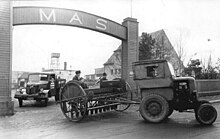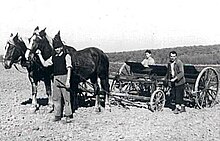Drill seed

The drill or row sowing is carried out with a seed drill or a seed drill.
The special feature are small seed coulters that pull a groove several centimeters deep into the seed bed - seeds are introduced from the seed box through a tube using a rotating cam roller (drilled = rotating feed). The advantage of this agricultural machine for sowing plant seeds from is the exact and even depth of the seed , which leads to less bird damage and an even field emergence . As a result, the amount of seed can be reduced by around 30% compared to broad sowing .
A conventional seed drill has so-called drag coulters, small ploughshares for limited tearing up of the arable land. The seeds are deposited in the small furrows . Then they are closed again by a following harrow. In addition to the drag coulters, there are other devices for working the seeds into the ground.
So-called direct seed drills have also been in use since around 1970. With them, which takes direct seeding of the crop without plowing. The reduction of soil cultivation protects the soil fauna ( e.g. earthworms ), which is why no-till is a gentler form of land management. However, it is not practicable everywhere; For example, this type of cultivation - known as minimal tillage - lowers the soil temperature. The plant residues remaining on the ground cause the soil to be shaded, which has a significant impact on germination and subsequent plant cultivation measures. No-till can also be used sensibly in organic farming. By purchasing a direct seed drill jointly, the costs can be shared among several farmers, whereby more profitable cultivation is possible.
history
The Sumerians had already invented a primitive seed drill. Excavation finds of seed bands from the time of the Han dynasty in the 2nd century BC Chr. Suggest a seed drill with several seed lines. Apparently such a machine was made by an official named Zhao Guo around 85 BC. Known. At that time it was said that it could sow 7 hectares a day. The first European seed drill was patented by Camillo Torello in Venice in 1566 . It was continuously developed: Around 1700 there were somewhat robust versions (e.g. by Jethro Tull ), but it took until the middle of the 19th century until it was reliable and economically usable. In 1834, the Bohemian agronomist Franz Horsky presented a seed drill.
Initially, the seed drill required 2 horses and a crew of three (horse handlebar, machine operator and seed coulter controller). The daily sowing capacity was 7–12 ha. With a tractor-drawn sowing combination, a tractor driver can sow many times this area today.
See also
literature
- Klaus-Ulrich Heyland (ed.): Special crop production . 7th edition. Ulmer, Stuttgart 1952/1996, ISBN 3-8001-1080-6 .
- Ernst Klapp : Textbook of arable and crop production . Paul Parey publishing house, Berlin and Hamburg 1958.



